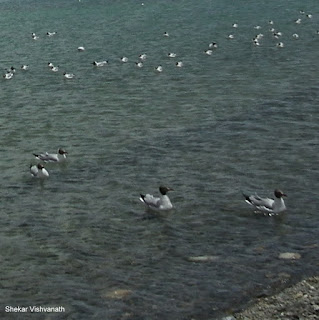| Great White Pelican Thol 060311 |
I saw some colonies of Great White Pelican at Thol Bird Sanctuary near Ahmedabad in Gujarat on 060311.
| Great White Pelican Thol 060311 |
| Great White Pelican Thol 060311 |
| Great White Pelican Thol 060311 |
More or less in the middle of the lake there was a colony of several Great White Pelicans.The great white pelican is well adapted for aquatic life. I took these photographs with Fuji HS 10 camera.
| Great White Pelican Thol 060311 |
The Great White Pelican propels and takeoff from the water surface with the help of its short strong legs and webbed feet. The male has pinkish skin on its face and the female has orange skin during the breeding season. The existence of pure white plumage, a bare pink facial patch around the eyes and pinkish legs in the Great White Pelican differentiates it from the Dalmatian Pelican.
| Great White Pelican Thol 060311 |
The immature Great White Pelicans are grey and have dark flight feathers.
| Dalmatian Pelican? Thol 060311 |
While going through the photographs, I came across a photograph where a solitary pelican with orange-red lower mandible and no bare pink facial patch around the eyes was seen swimming in front of a Great White Pelican colony.
| Dalmatian Pelican? Thol 060311 |
Generally, Dalmatian Pelican has no bare pink facial patch around the eyes and during breeding season orange-red lower mandible. It is listed as Vulnerable by the IUCN Red List of Threatened Species.
Both species are winter visitor to Gujarat.
In my list of birds that I have seen and photographed, the Great White Pelican is at 44th place.
1) Birds of the Indian Subcontinent by Richard Grimmett, Carol Inskipp and Tim Inskipp
2) Birds of South Asia, The Ripley guide by Pamela C. Rasmussen and John C Anderton
3) The Book of Indian Birds by Salim Ali
4) A Pictorial Field Guide to Birds of India by Bikram Grewal, Sumit Sen, Sarwandeep Singh, Nikhil Devasar and Garima Bhatia
5) The Wikipedia



